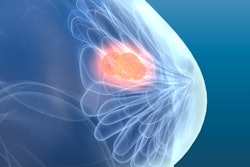
A radiomics-based machine-learning model can differentiate bone islands and osteoblastic bone metastases on abdominal CT scans at a level comparable to an experienced radiologist, according to research published online March 30 in Radiology.
A multi-institutional team of researchers led by Dr. Ji Hyun Hong of Hallym University College of Medicine in Seoul, South Korea, developed a radiomics model for distinguishing sclerotic bone lesions on contrast-enhanced abdominal CT studies. In testing, the algorithm yielded similar diagnostic performance to two experienced musculoskeletal radiologists and significantly better results than a third-year radiology resident.
What's more, the model showed higher performance than relying on just a single imaging feature alone.
"These findings suggest that a radiomics model can assist an inexperienced radiologist when a sclerotic bone lesion is encountered at CT," the authors wrote.
Sclerotic bone lesions are common incidental findings on abdominal CT exams, but their treatment strategy depends on the type of lesion. Bone islands aren't clinically significant, and they don't need to be treated, according to the authors. That's not the case, though, for an osteoblastic metastasis.
The researchers sought to utilize radiomics and machine learning to help with this challenging diagnostic task. They first gathered training and test sets by searching radiology reports from contrast-enhanced abdominal CT scans performed between 2015 and 2019 at Seoul St. Mary's Hospital and Kangdong Sacred Heart Hospital, both in Seoul.
Axial images from 177 patients -- 89 with a bone island and 88 with metastasis -- were loaded into open-source software (ITK-SNAP) for segmentation; the resulting segmented image masks were then manually refined by two radiologists. Next, the researchers utilized version 1.2.2 of the syngo.via Frontier software (Siemens Healthineers) to perform radiomics analysis.
Ten radiomics features were then used to train a random-forest model. After initial training and 10-fold crossvalidation, the model was applied to an independent test set of 64 patients, including 41 with an osteoblastic metastasis and 23 with a bone island. In addition, the cases in the test set were reviewed by three readers -- two radiologists with 12 and five years of musculoskeletal radiology experience, respectively, as well as a third-year radiology resident.
| Performance of AI for distinguishing sclerotic bone lesions on CT | ||||
| Radiologist 1 | Radiologist 2 | Radiologist 3 (third-year resident) | Radiomics model | |
| Sensitivity | 95% | 98% | 78% | 80% |
| Specificity | 91% | 96% | 83% | 96% |
| Accuracy | 94% | 97% | 80% | 86% |
| Area under the curve (AUC) | 0.95 | 0.96 | 0.88* | 0.96* |
The researchers also reported that the radiomics model was superior to relying just on individual attenuation-related features (AUC = 0.79) or shape-related features (AUC = 0.51).
"Overall, this abdominal CT scan study demonstrates the feasibility of radiomics [deep learning] for detection and classification of bone metastases, opening the possibility for an automated tool that could provide a significant clinical benefit," said Dr. Michael Vannier of the University of Chicago in an accompanying editorial. "The fields of artificial intelligence and/or [deep learning] and radiomics are rapidly evolving, so we can anticipate that tools like this one may become available as an integral part of future radiology practice."



















